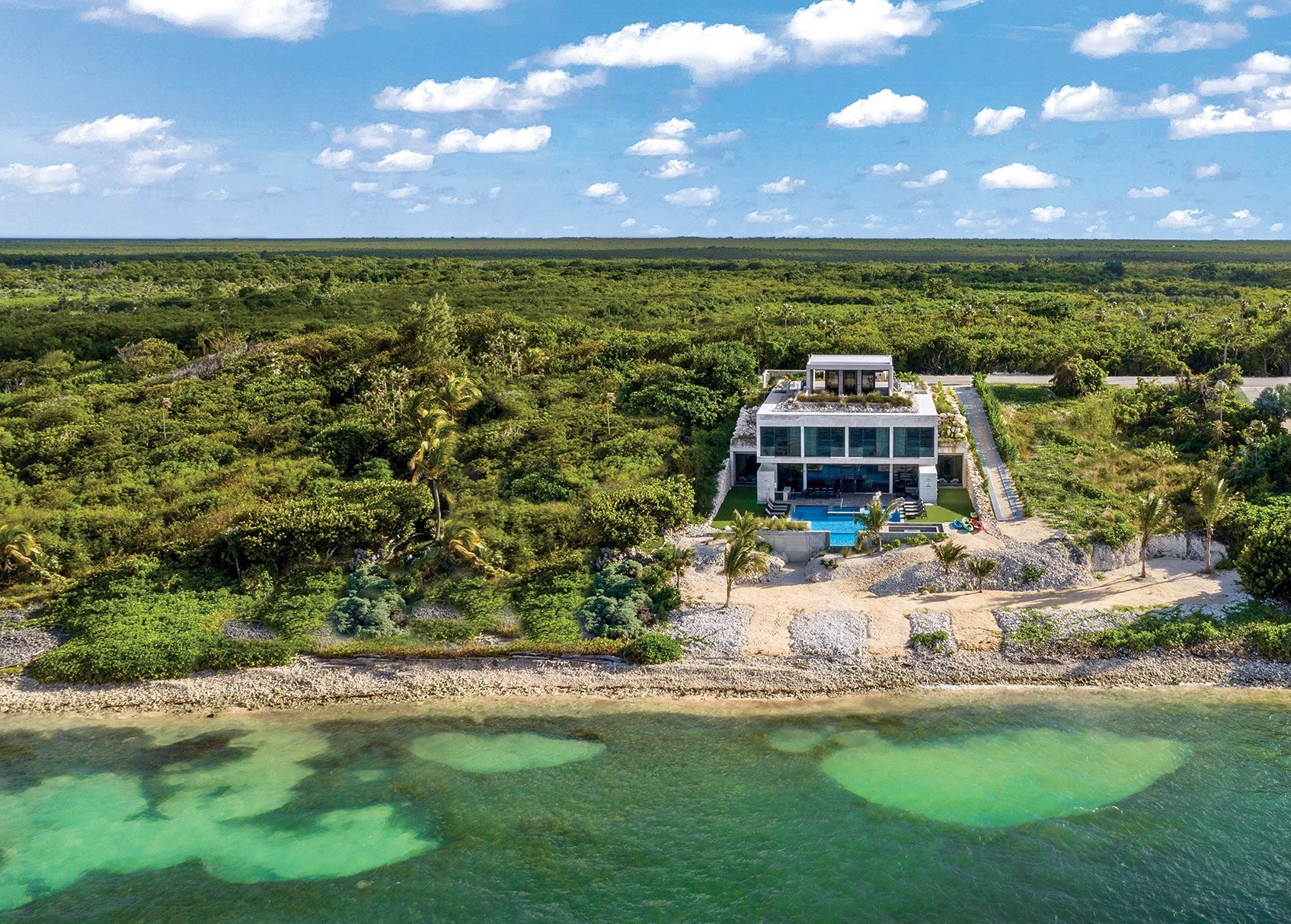
BELLA ROCCA,
CAYMAN ISLANDS
SHOWCASE | BELLA ROCCA, CAYMAN ISLANDS
A moody, mysterious hidden mansion carved into the East End cliff has more than a little of the James Bond vibe about it.
Words by Natasha Were. Photography by www.ten20photography.com
Mike Stroh, principal architect at Trio Architecture, spied the piece of land where Bella Rocca is built while boating one day. It was September 2020, and the way the world vacationed was changing. With social distancing the priority, families sought private refuges where they could enjoy all the comforts and amenities of a hotel in complete seclusion.
At 40 feet above sea level on the north shore, with uninterrupted sea views, Stroh knew that this was a unique opportunity to create something extraordinary. Trio Architecture decided to purchase the land and develop Bella Rocca independently. With no client involved whose wishes they needed to accommodate, it was a chance to do something bold, dramatic and personal and to work holistically, ensuring there was clear continuity between the architecture and the interior design.
“I sketched the design on the back of a napkin,” the architect recalls. “I wanted the house to be buried in the cliff so that from the sea you would see only glass and concrete, while from the road just the simple box-like entrance would be visible – everything else is below that. Rather than an egocentric design that concentrates on the design of the house itself, the intention was always to make it a celebration of the sea.”
Because three sides of the property are effectively buried in the cliffside, with access from above and behind and openings only on the sea-facing side, the guest spaces are only one room deep. This allowed Stroh to create four sea-view principal suites, two additional children’s or staff rooms on the middle level, and a vast open plan living area, flanked by two more sea-view guest rooms with private terraces, on the lowest floor.
It was estimated that excavating the rock from the site would take three solid weeks. It took three months. But that cloud had a silver lining: once Multibuilt Construction began the groundwork, it was discovered that the rock had an abundance of semi-precious Caymanite. And so, not only was it possible to repurpose all the rock to then build the property, but the Caymanite became a recurring design detail, its striations visible in the rock walls surrounding the outdoor showers, in the retaining walls, and inserted into the property’s logo.
By leaving the concrete exposed, the property blends into its surroundings from the outside, and in time, the vegetation and vines planted around the property will grow up and hide it further. The same concrete is frequently left visible inside, creating a cave-like ambience where the main character is always the views of the deep blue sea. Rather than compete with the colours of the sea, interior designer Carolina Hane says, interior palettes were kept neutral and muted. Visual interest is instead introduced through texture and form.
Tactile wall coverings, smooth, rounded pebbles, glossy hardwood accents, and plush fabrics appear repeatedly throughout the interiors, with soft curves and organic shapes providing a counterpoint to the hard surfaces and clean lines.
There’s a certain mystique to entering and descending through the levels of this property: whether one takes the perforated metal stairs, that offer glimpses through a thousand tiny holes of the scene that awaits below, or one steps into the transparent cylindrical elevator, the journey takes one from daylight at road level, down through a moody, shadowy second level guarded by enigmatic sentry-like stone sculptures, before emerging into the bright, airy entertaining area.
The guest bedrooms are designed to evoke the feel of serene hotel suites, with comfortable seating areas, separate dressing rooms, and spacious bathrooms with grotto-like walk-in showers. Although equipped with every comfort and convenience, the accessories are subtle and pared back so as not to distract from the design’s primary intent. The four principal suites extend to the outer edge of the covered terrace below, and with no balcony beyond the floor-to-ceiling panes of glass, from the poured concrete beds all one sees is the sea. It’s what Stroh calls the cruise ship effect – the sensation that the sea reaches all the way to the edge of the room.
Even when performing one’s ablutions, the sight of the turquoise tones is never lost, thanks to large windows in the showers that allow one to look through the suite and to the mirrors behind the vanities that reflect the views. Should you step into the outdoor showers and peer between the curtains of vines and Caymanite-flecked walls, the same endless sea is visible.
Descending into the lower level, the property opens up in its full panoramic glory. A triumph of symmetry and balance, the vast open-plan gathering space is as expansive inside as the space outside it.
Across its north side, wall-to-wall, floor-to-ceiling glass doors open onto a covered terrace that eases the transition between the interior and the equally well-proportioned exterior.
Beyond the shaded dining, seating, and barbecuing space lies a playground for all ages: sun loungers are ranked along each side of the generous pool, twin splash pads and an integrated hot tub ensure fun in the sun, the sunken firepit invites evening stargazing, and steps lead down to the 200-foot sand and pebble beach below.
In the main living area, soft white sofas and easy chairs arranged around a sculptural coffee table, all positioned squarely before the views, form the heart of the space. Off to one side, in the spacious chef’s kitchen, custom cabinetry in driftwood hues and terrazzo countertops in sand tones imbue it with warmth, and the twin kitchen islands, connected by a hardwood bar, make it a convivial, social space to cook.
Opposite this, in the dining area, the roughness of the concrete wall is softened by natural fibre pendant lights, tall green plants and the rich tones of hardwood that form the base of the 14-seater dining table. Two large-scale commissioned artworks in black and white again avoid competing colours yet add a luminous quality and equilibrium to this space.
Throughout the interior, a multitude of earthy, weathered elements and accessories create a grounded, natural aesthetic. From the handmade, slightly uneven ceramic pendants in the kitchen and the strings of tarnished brass bells that hang behind the dining area to the slight patina of the vintage mirrors behind the coffee bar and wet bar (which, once again, reflect the Caribbean Sea) these elements celebrate the beauty in the imperfect.
In Bella Rocca, a blank canvas has been transformed into a work of art. The property’s uncomplicated architecture belies an intricately conceived design that comes full circle. The rounded, stacked stone towers that greet one on entering and are echoed in the smooth pebbled floors of the showers and stairwell are all a prelude to the sea-smoothed stones on the beach; the concrete that makes the property almost invisible from the outside is equally visible on the inside; the Caymanite – the ‘beautiful rock’ that gives the property its name – excavated from the site appears in subtle forms time and again, and the hero feature, the sea, is framed, reflected, and celebrated at every turn.
SERVICE PROVIDERS & SUPPLIERS IN THE CAYMAN ISLANDS
Architect: Mike Stroh, Trio Architecture
Interior Designer: Carolina Hane, Trio Architecture and Interiors
Construction Management: Trio Architecture
Construction Consultants and Collaborators: Core Construction
Engineers: Trio Architecture
Elevator: AndroGroup Elevators Ltd.
Home Automation and A/V: The Audiophile Group
Home Scent: CASA by Carolina Hane
Kitchen Design: Trio Architecture and Interiors
Kitchen Appliances: Bon Vivant
Project Management: Trio Architecture and Interiors
Pool Design: Oasis Pool & Spa
Selected Furniture and Accessories: Sticks and Stones




















